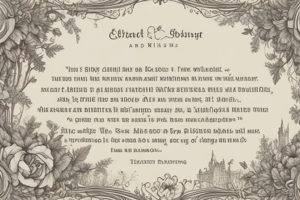Podcast
Questions and Answers
What is the title of the famous poem by Elizabeth Barrett Browning?
What is the title of the famous poem by Elizabeth Barrett Browning?
- The Love Letters
- Sonnet 18
- How Do I Love Thee? (correct)
- Sonnet 43 (correct)
Which American poet was influenced by Elizabeth Barrett Browning?
Which American poet was influenced by Elizabeth Barrett Browning?
- Emily Dickinson (correct)
- Henry Wadsworth Longfellow
- Edgar Allan Poe
- Walt Whitman
Why did Elizabeth Barrett Browning and her husband have to marry secretly?
Why did Elizabeth Barrett Browning and her husband have to marry secretly?
- Because of their different social status
- Because of their age difference
- Because of her father's disapproval (correct)
- Because of their religious differences
Where did Elizabeth Barrett Browning and her husband move to after their marriage?
Where did Elizabeth Barrett Browning and her husband move to after their marriage?
At what age did Elizabeth Barrett Browning die?
At what age did Elizabeth Barrett Browning die?
What is the central theme of Elizabeth Barrett Browning's poem 'Sonnet 43'?
What is the central theme of Elizabeth Barrett Browning's poem 'Sonnet 43'?
What literary device does Elizabeth Barrett Browning employ in 'Sonnet 43' to describe her love?
What literary device does Elizabeth Barrett Browning employ in 'Sonnet 43' to describe her love?
To whom is the speaker of 'Sonnet 43' likely addressing?
To whom is the speaker of 'Sonnet 43' likely addressing?
What is the tone of 'Sonnet 43'?
What is the tone of 'Sonnet 43'?
What does the speaker hope to achieve in 'Sonnet 43'?
What does the speaker hope to achieve in 'Sonnet 43'?
What is notable about Elizabeth Barrett Browning's achievement as a poet?
What is notable about Elizabeth Barrett Browning's achievement as a poet?
What is the significance of 'Sonnet 43' in the English language?
What is the significance of 'Sonnet 43' in the English language?
What is the speaker's desire in 'Sonnet 43' beyond her mortal life?
What is the speaker's desire in 'Sonnet 43' beyond her mortal life?
What is the main purpose of the poem 'Sonnet 43'?
What is the main purpose of the poem 'Sonnet 43'?
What is the rhyme scheme of 'Sonnet 43'?
What is the rhyme scheme of 'Sonnet 43'?
What is the implication of the speaker's desire to love her beloved even after death?
What is the implication of the speaker's desire to love her beloved even after death?
What is the significance of the poem's structure and form?
What is the significance of the poem's structure and form?
What is the effect of the literary device imagery in the poem?
What is the effect of the literary device imagery in the poem?
What is the meter of the poem 'Sonnet 43'?
What is the meter of the poem 'Sonnet 43'?
What is the primary theme of death in the poem?
What is the primary theme of death in the poem?
What is the literary device used in the poem to compare two things?
What is the literary device used in the poem to compare two things?
What is the tone of the poem 'Sonnet 43'?
What is the tone of the poem 'Sonnet 43'?
What is the effect of the poem's structure on the reader?
What is the effect of the poem's structure on the reader?
What does the speaker's love for her husband compare to in terms of depth and breadth?
What does the speaker's love for her husband compare to in terms of depth and breadth?
What literary device does Barrett Browning use in line 2 to convey the idea of ongoing love?
What literary device does Barrett Browning use in line 2 to convey the idea of ongoing love?
What is the significance of the speaker's love in everyday life?
What is the significance of the speaker's love in everyday life?
What is the central idea of the last thirteen lines of the poem?
What is the central idea of the last thirteen lines of the poem?
What is the tone of the lines 'I love thee to the level of every day's / Most quiet need, by sun and candle-light'?
What is the tone of the lines 'I love thee to the level of every day's / Most quiet need, by sun and candle-light'?
What is the significance of the speaker's love in the poem?
What is the significance of the speaker's love in the poem?
How does the speaker's love for her husband compare to the ends of being and ideal grace?
How does the speaker's love for her husband compare to the ends of being and ideal grace?
What is the primary way the speaker expresses her love in the poem?
What is the primary way the speaker expresses her love in the poem?
What does the speaker's love for her husband compare to in terms of its purity?
What does the speaker's love for her husband compare to in terms of its purity?
What is the speaker's attitude towards her love for her husband?
What is the speaker's attitude towards her love for her husband?
What is the significance of the speaker's reference to 'old griefs'?
What is the significance of the speaker's reference to 'old griefs'?
What is the significance of the speaker's comparison of her love to 'the faith of a child'?
What is the significance of the speaker's comparison of her love to 'the faith of a child'?
What is the significance of the speaker's reference to 'lost saints'?
What is the significance of the speaker's reference to 'lost saints'?
What is the tone of the lines 'I love thee with the breath, / Smiles, tears, of all my life…'?
What is the tone of the lines 'I love thee with the breath, / Smiles, tears, of all my life…'?
What is the effect of the speaker's use of similes in the poem?
What is the effect of the speaker's use of similes in the poem?
What is the significance of the speaker's love being 'freely' given?
What is the significance of the speaker's love being 'freely' given?
What is the effect of the speaker's use of religious motifs in the poem?
What is the effect of the speaker's use of religious motifs in the poem?
What is the significance of the speaker's declaration of love in the poem?
What is the significance of the speaker's declaration of love in the poem?
What is the central idea of the poem's final line?
What is the central idea of the poem's final line?
What is the significance of the title 'Sonnets From the Portuguese'?
What is the significance of the title 'Sonnets From the Portuguese'?
What is the primary characteristic of the speaker's love in the poem?
What is the primary characteristic of the speaker's love in the poem?
What is the nature of the relationship between Elizabeth Barrett Browning and her husband?
What is the nature of the relationship between Elizabeth Barrett Browning and her husband?
What is the significance of the poem's historical background?
What is the significance of the poem's historical background?
What is the tone of the poem's final line?
What is the tone of the poem's final line?
Flashcards are hidden until you start studying
Study Notes
Elizabeth Barrett Browning's Life and Career
- 'How Do I Love Thee? Let Me Count the Ways' or 'Sonnet 43' is one of Elizabeth Barrett Browning's most famous poems.
- She was a renowned Victorian poet who achieved acclaim in her lifetime.
- Barrett Browning influenced many British and American poets, particularly Emily Dickinson.
- She was a prolific writer, and her poems caught the attention of Robert Browning, another famous poet of the time.
Marriage and Later Life
- Elizabeth Barrett Browning and Robert Browning married secretly due to her father's disapproval.
- As a result, her father disinherited her.
- The couple moved to Italy and supported each other's writing.
- Elizabeth Barrett Browning died in Italy at the age of 55.
Elizabeth Barrett Browning
- A renowned Victorian poet who achieved acclaim in her lifetime
- Influenced many British and American poets, particularly Emily Dickinson
'Sonnet 43' (How Do I Love Thee? Let Me Count the Ways)
- One of Browning's most famous poems in the English language
- Expresses the speaker's unending passion for her beloved
- The speaker loves her lover with all of her being, and hopes God will grant her the ability to love him even after she has passed
Themes in 'Sonnet 43'
- Love and devotion
- Relationships
- Addressed to her listener, likely her husband Robert Browning
- Makes nature-based comparisons to depict her love accurately and movingly
Elizabeth Barrett Browning and Sonnet 43
- Elizabeth Barrett Browning is a renowned Victorian poet who achieved acclaim in her lifetime and influenced many British and American poets, including Emily Dickinson.
- Sonnet 43, also known as "How Do I Love Thee? Let Me Count the Ways," is one of Browning's most famous poems and one of the most recognizable poems in the English language.
Themes
- The poem explores the theme of love, specifically the speaker's unending passion for their beloved.
- Death is also a theme, as the speaker hopes that God will allow her to love her partner even in death, revealing a spiritual aspect to their love.
Structure and Form
- Sonnet 43 is a Petrarchan sonnet, consisting of 14 lines with a fixed rhyme scheme of abba abba cdcdcd.
- The poem follows the traditional metrical pattern of iambic pentameter, with each line containing five sets of two beats (unstressed and stressed).
Literary Devices
- Browning uses various literary devices, including imagery, simile, and alliteration, to create vivid and sensory experiences for the reader.
- Imagery is a key device, as seen in lines like "I love thee to the level of every day's / Most quiet need, by sun and candle-light", which appeal to the reader's senses.
Sonnet 43 Analysis
- The poem explores the speaker's deep love for her husband, with the last 13 lines devoted to enumerating the ways she loves him.
Lines 2-4
- The speaker's love is described as infinite, reaching the depth, breadth, and height of her soul.
- The love is so immense that it cannot be "seen" or measured, being "out of sight" and extending to the "ends of being and ideal grace".
- Barrett Browning uses consonance in line 2, repeating the "th" sound to convey the ongoing nature of her love.
Lines 5-6
- The speaker's love is not only extraordinary but also present in everyday life, meeting her "most quiet need" by both "sun and candle-light".
- Her love is likened to basic necessities, highlighting its importance and constancy.
Lines 7-8
- The speaker outlines two additional ways she loves her husband, further emphasizing the depth and variety of her emotions.
Sonnet 43 Analysis
- The poem expresses the speaker's love for her husband, comparing it to men's striving for right and turning from praise.
- The speaker loves her husband freely and purely, without seeking thanks or attention, just like good and just men who do good deeds because it is what they have to do.
Lines 9-10
- The speaker loves her husband with the same passion she had for her old griefs, which can be defined as things she passionately despises.
- She also loves him with the faith of a child, which is steadfast and true.
Lines 11-13
- The speaker loves her husband with a love she seemed to lose, comparing it to her lost saints, people she once loved and adored in her life.
- This love is now transferred to her husband, and she loves him with all that she is: her breath, smiles, and tears.
- The speaker confesses that she loves her husband with all that has made up her life.
Lines 13-14
- The poem concludes with the speaker acknowledging her willingness to love her husband forever, if God chooses to allow her to do so.
- This final statement expresses her devotion and commitment to her husband.
Poem Analysis
- The speaker declares that their love will only grow stronger even after death, emphasizing its eternal nature.
- The poem expresses the speaker's confidence that their love will continue to flourish despite physical separation or mortality.
Historical Background
- Elizabeth Barrett Browning fell in love with Robert Browning after he praised her writing.
- The couple exchanged letters before marrying, despite knowing her father would not approve.
- The Brownings' marriage was built on mutual love, respect, and admiration for each other's literary works.
- Robert Browning affectionately called Elizabeth "my little Portuguese", inspiring the title of her poetry collection, Sonnets From the Portuguese.
Studying That Suits You
Use AI to generate personalized quizzes and flashcards to suit your learning preferences.




